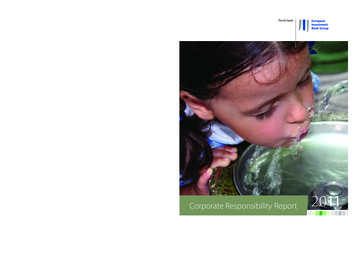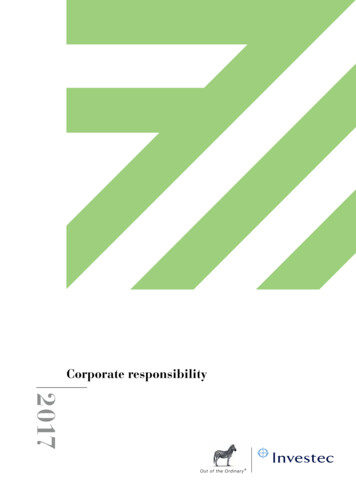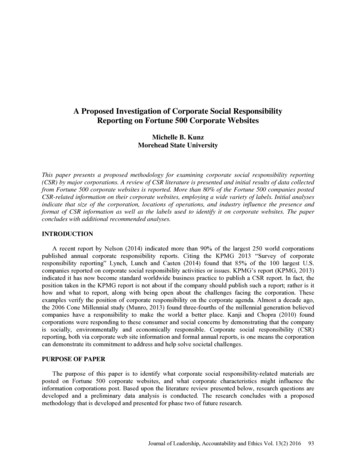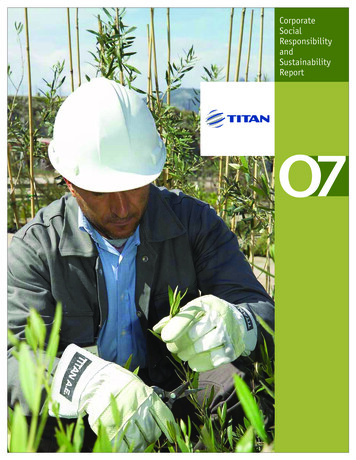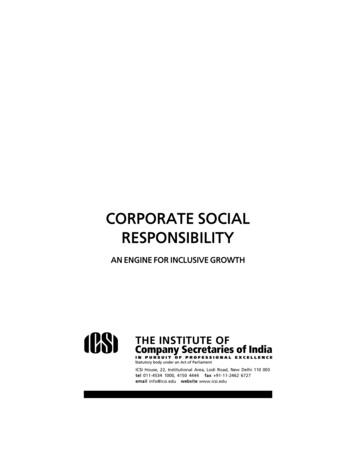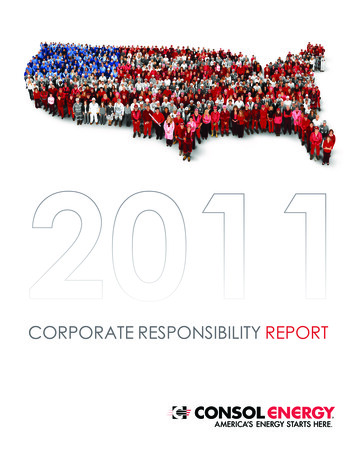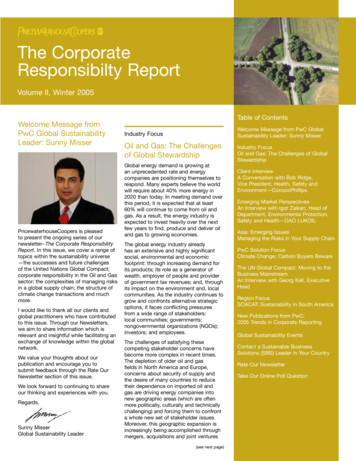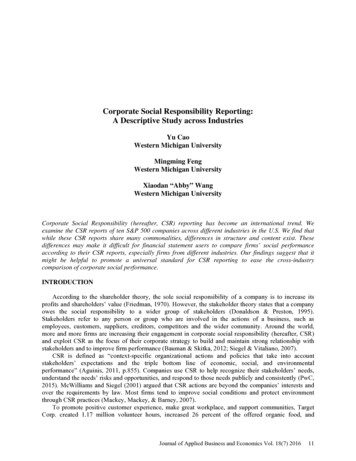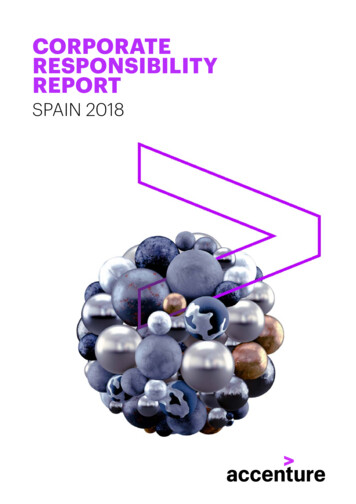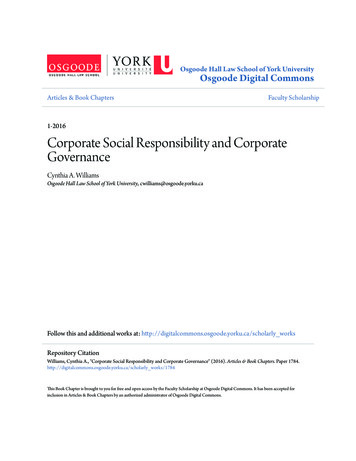
Transcription
Osgoode Hall Law School of York UniversityOsgoode Digital CommonsArticles & Book ChaptersFaculty Scholarship1-2016Corporate Social Responsibility and CorporateGovernanceCynthia A. WilliamsOsgoode Hall Law School of York University, cwilliams@osgoode.yorku.caFollow this and additional works at: http://digitalcommons.osgoode.yorku.ca/scholarly worksRepository CitationWilliams, Cynthia A., "Corporate Social Responsibility and Corporate Governance" (2016). Articles & Book Chapters. Paper rly works/1784This Book Chapter is brought to you for free and open access by the Faculty Scholarship at Osgoode Digital Commons. It has been accepted forinclusion in Articles & Book Chapters by an authorized administrator of Osgoode Digital Commons.
Corporate Social Responsibility and Corporate GovernanceCynthia A. WilliamsOsler Chair in Business LawOsgoode Hall Law School, York University, Toronto, CanadaChapter for OXFORD HANDBOOK OF CORPORATE LAW AND GOVERNANCE(Jeff Gordon & Georg Ringe, eds., forthcoming)AbstractCorporate social responsibility has become a subject of growing importance in business and law.Today, no analysis of corporate governance systems would be complete without considering thepressures on companies to be seen as responsible corporate citizens. This chapter first provides adescriptive overview of developments in the field, including increasing voluntary and requiredenvironmental, social and governance (ESG) disclosure; and proliferating voluntary andmultilateral standards for responsible corporate behavior. This chapter then reviews some of themore significant empirical evidence on the financial results of companies’ implementation ofcorporate responsibility initiatives, including the effects of such initiatives on innovation, trust,and social welfare. It concludes with an analysis relating these developments to arguments overthe objectives of the corporation and the shareholder/stakeholder debate.I.INTRODUCTIONCorporate social responsibility is a topic that has been given increased attention in the lasttwo decades in practice and in theory, both in management and law. Defined in an influential1970’s article as “the firm’s considerations of, and response to, issues beyond the . . . economic,technical, and legal requirements of the firm to accomplish social benefits along with the1
traditional economic gains which the firm seeks,” 1 the European Commission more simplydefined it in 2011 as “the responsibility of enterprises for their impacts on society.” 2As theCommission stated in adopting that definition, “[e]nterprises should have in place a process tointegrate social, environmental, ethical, human rights and consumer concerns into their businessoperations and core strategy in close collaboration with their stakeholders.” 3 Thus, the emphasishas shifted from philanthropy and attention to corporate action “beyond law,” to an inquiry intohow a company conducts its business. Indicative of this shift, many academics and practitionersin management now refer to the topic as corporate responsibility, not corporate socialresponsibility, as will this author. 4What is some evidence of a developing norm of corporate responsibility? Few globalcompanies today fail to highlight their social initiatives and performance on their websites, whileover 90% of the Global 250 companies voluntarily disclose more environmental, social andgovernance (ESG) information than required by law. 5 Voluntary, transnational standards of bestsocial and environmental practices are proliferating in virtually every industry, many withassociated certification schemes and requirements for third-party attestation or auditing. 6 Thesevoluntary initiatives are increasingly being supplemented by domestic and multilateralgovernment actions to encourage, or in some cases require, companies to pay closer attention to1Keith Davis, The Case For and Against Business Assumption of Social Responsibilities, 16 AM. MNGMT. J. 312,312 (1973).2European Commission, A Renewed European Union Strategy 2011-14 for Corporate Social Responsibility, COM(2011) 681, ¶ 3.1.3See id.4See Céline Gainet, Exploring the Impact of legal Systems and Financial Structures on CR, 95 J. BUS. ETHICS 195,197 (2010)(discussing shift in nomenclature from “corporate social responsibility” to “corporate responsibility,” for,among other reasons, encompassing the concept of both social and environmental responsibilities in a single term).5See KPMG, The KPMG Survey of CR Reporting 2013, available 3-exec-summary.pdf .6See Margaret M. Blair, Cynthia A. Williams & Li-Wen Lin, The New Role for Assurance Services in GlobalCommerce, 33 J. CORP. L. 325 (2008).2
the social and environmental consequences of their actions and to disclose more informationabout those consequences. 7Investors as well have become more attentive in recent years to environmental and socialrisks in portfolio companies, and therefore more concerned with corporate responsibility. Globalassets under management with sustainability screens have risen 61% since 2012, to US 21.4trillion at the start of 2014. 8 Institutions managing US 45 trillion of invested capital havecommitted to the U.N. Environment Program’s Principles for Responsible Investment (PRI),which require investors to incorporate ESG issues into investment practices across their assetclasses. 9 And, as of 2015, over US 92 trillion of the world’s invested capital backs the CarbonDisclosure Project (CDP) ’s work with 2,000 companies around the world to gather data on thosecompanies’ greenhouse gas emissions. 10 These data are then provided to Bloomberg forincorporation with other ESG data that Bloomberg now sells, since 2009, to investors around theworld. 11 Indeed, corporate responsibility itself has become an industry, one a critical NGOnoted has London “awash with PR consultants, social auditors, firms providing verification or‘assurance’ for companies’ social and environmental reports, and bespoke investment analysts allvying for business.” 12While these trends indicate that corporate responsibility has achieved some place withinmainstream corporate and investor activities, that place is deeply contested, in both theory and7See Parts II, B, 2 and III , infra.Global Sustainable Investment Alliance, The Global Sustainable Investment Review 2014, available atwww.sustainabilityHQ.com.9United Nations Environment Program Principles for Responsible Investment, available athttp://www.unpri.org/about-pri.10Carbon Disclosure Project, Catalyzing Business and Government Action, available at http://www.cdp.net/enUS/Pages/About-Us.aspx.11See Table 3, infra, for a summary of the environmental and social data that Bloomberg now sells to its broker anddealer clients.12Christian Aid, Behind the Mask: The Real Face of Corporate Social Responsibility 8 (2004).83
practice. Everything from the history of corporate responsibility, its importance, its effects, andits legitimacy is subject to challenge, depending on the underlying corporate governance systemof a country in question, how countries arrange their social welfare provision, the relationship ofthe state to the market, and even the theory of the nature of the corporation one holds. Inimportant respects corporate responsibility is both too strong and too weak: too strong anassertion of a social role for the corporation and its directors to coexist comfortably with theview of the purely economic role of the corporation within shareholder-focused corporategovernance systems, and yet too weak for academics taking a stakeholder view of thecorporation who are concerned with global problems they view companies as having helped tocreate, including climate change, environmental degradation, exploitative labor conditions andworsening economic inequality.This chapter will proceed as follows. Part 2 will describe voluntary corporate responsibilityinitiatives, followed in Part 3 by some of the more significant legal developments on the topic.Part 4 will discuss empirical evidence about the financial and social effects of corporateresponsibility, including interactions with corporate governance structures. Part 5 will evaluatethese corporate responsibility trends, and Part 6 will conclude.II. VOLUNTARY CORPORATE RESPONSIBILITY INITIATIVESA. Corporate Responsibility ReportingThe clearest demonstration of the evolution of corporate responsibility from academic theoryto mainstream business practice is in the trends with respect to corporate reporting of4
environmental, social and governance (ESG) information. 13 While some jurisdictions are startingto require ESG reporting (as described below), much of this reporting is still voluntary. It canthus be interpreted as an indication of companies’ perceptions of the social expectations ofbusiness, even as companies seek to manage those expectations through their corporateresponsibility reporting. 14The most comprehensive source of data on ESG reporting is that done by KPMG in theNetherlands. KPMG published its first ESG report in 1993, and its most recent in 2013. In1993, 12% of the top 100 companies in the OECD countries (ex. Japan) published anenvironmental or social report. 15 By 2013, 76% of the top 100 companies in the Americaspublish a separate corporate responsibility report, as do 73% of top 100 companies in Europe and71% in Asia. 16 Of the largest 250 companies globally, reporting rates are 93%. 17 The GlobalReporting Initiative (GRI)’s voluntary, multi-stakeholder framework for ESG reporting hasemerged as the clear global benchmark: 78% of reporting companies worldwide and 82% of theGlobal 250 use GRI as the basis for their corporate responsibility reporting. 18 Of particular note,13For an excellent overview of the evolution of corporate responsibility as an academic theory in the managementliterature, see Archie V. Carroll, Corporate Social Responsibility: Evolution of a Definitional Construct, 38 BUS. &SOC’TY 268 (1999).14See Sara B. Feldner & Kati T. Berg, How Corporations Manage Industry and consumer Expectations via the CRReport, 8(3) PUBLIC RELATIONS J. (2014), available at www.prsa.org/prjournal; Ronen Shamir, The DeRadicalization of Corporate Social Responsibility, 30 CRITICAL SOCIOLOGY 669, 675 (2004).15See Ans Kolk, A Decade of Sustainability Reporting: Developments and Significance, 3 INT’L J. ENVIRONMENT &SUSTAINABLE DEVEL. 51, 52 Figure 1 (2004). KPMG has changed the format of the report since its original 1993report on corporate responsibility reporting, so direct comparisons are not possible between the Global 250 in 1993and the Global 250 in 2013.16KPMG, The KPMG Survey of CR Reporting 2013, at 10, available 3-exec-summary.pdf (last visited March 5,2015).17See id.18See id.at 11. The Global Reporting Initiative is now in its fourth iteration. It has been developed by, and is usedby, thousands of companies, governments, and non-profit entities around the world to report on the economic,environmental, social and governance effects of entities’ actions. See Global Reporting Initiative, available athttp://www.globalreporting.org.5
slightly over half (59%) of the Global 250 now have their reports “assured,” most often (twothirds of the time) by the specialist bureaus of the major accountancy firms. 19In addition to the quantity of corporate responsibility reporting, KPMG also evaluates thequality of reporting. Here, European companies generally do substantially better than those inAsia or the Americas (average quality scores of 71 out of 100 in Europe versus 54 for companiesin the Americas and 50 in Asia Pacific). 20 Within the Global 250, companies are starting to seemore opportunities than risks from social and environmental factors, such as for the developmentof new products and services. Eighty-seven percent of the Global 250 identify climate change,material resource scarcity and trends in energy and fuel as “megatrends” that will affect theirbusiness. 21 Ultimately KPMG concludes that “[m]any companies no longer see corporateresponsibility as a moral issue, but as core business risks and opportunities.” 22 This conclusionis consistent with the views of prominent management academics Michael Porter and MarkKramer, 23 and Abagail McWilliams and Donald Siegel, 24 each of whom (among others) hasargued for companies to use corporate responsibility initiatives as part of their business strategiesto promote competitive advantage.B. Substantive Corporate Responsibility Initiatives1. Private Initiatives19See KPMG 2013 Report, supra note 16, at 11.See id. at 14.21See id. at 14-15.22See id. at 15.23See Michael E. Porter and Mark R. Kramer, Strategy and Society: The Link Between Competitive Advantage andCorporate Social Responsibility, HARV. BUS. REV. 78 ( DEC. 2006).24See Abagail McWilliams & Donald S. Siegel, Creating and Capturing Value: Strategic Corporate SocialResponsibility, Resource-Based Theory, and Sustainable Competitive Advantage, 37 J. OF MANGMT. 1480 (2011).206
The focus on expanded ESG disclosure has occurred concomitantly with the proliferation oftransnational, voluntary standards for what constitutes responsible corporate action. Thus, overthe past two decades such standards have been developed by states; public/private partnerships;multi-stakeholder negotiation processes; industries and companies; institutional investors;functional groups such as accountancy firms and social assurance consulting groups (many ofwhich did not exist more than ten years ago); NGOs; and non-financial ratings agencies. 25Standards have been developed in just about every industry, from apparel 26 to chemicals, 27extractives such as oil, gas and minerals 28 to conflict-free diamonds; 29 sustainable fisheries 30 andforestry; 31 project finance 32 and fair-trade goods such as coffee, tea, cocoa and cotton, 33 to namejust a few examples. Thousands of individual companies have adopted voluntary codes ofconduct establishing standards for responsible behavior, and some companies then engage third-25See Benedict Kingsbury, Nico Krisch, & Richard B. Stewart, The Emergence of Global Administrative Law, 68 L.& CONTEMP. PROBS. 15 (2005). The implications of these standards for theories of corporate governance, regulation,and economic development are profound, some of which the author has explored in prior work. See Cynthia A.Williams & John M. Conley, An Emerging Third Way? The Erosion of the Anglo-American Shareholder ValueConstruct, 38 CORN. INT’L. J. J. 493(2005).26See, e.g., The Fair Labor Associations, http://www.FLA.org, or the Workers’ Rights Consortium,http://www.workersrights.org. For a discussion of these and other standards for the global supply chain in theapparel industry, see Dara O’Rourke, Outsourcing Regulation: Analyzing Non-Governmental Systems of LaborStandards and Monitoring, 31 POL’Y STUD. J. 1 (2003).27See Responsible Care, http://www.canadianchemistry.ca/responsible care/index.php/en/responsible-care-history;Jean M. Belanger, Responsible Care in Canada: The Evolution of an Ethic and a Commitment, 27 CHEM. INT’L 2(March-April) 2005. The standards developed for responsible industrial chemicals production are in place in over60 countries, as of 2015, and now include greenhouse gas reporting and assurance.28See The Voluntary Principles on Security and Human Rights, available at http://www.voluntaryprinciples.org.29See The Kimberly Process, http://www.kimberleyprocess.com.30See, e.g., the Marine Stewardship Council certification process, http://www.msc.org.31See Forest Stewardship Council: Principles and Criteria for Forest Stewardship, available at http://www.fsc.org.Competition between the forest standards promulgated by business versus those promulgated by NGOs has beenextensively studied by leading students of regulation and political theory. See BENJAMIN CASHORE, GRAEME AULD& DEANNA NEWSOM, GOVERNING THROUGH MARKETS: FOREST CERTIFICATION AND THE EMERGENCE OF NONSTATE AUTHORITY (Yale Univ. Press 2004); Errol Meidinger, The Administrative Law of Global Private-PublicRegulation: the Case of Forestry, 17 EUR. J. OF INT’L LAW 47, 51 (2006).32See The Equator Principles, http://www.equator-principles.com. See also John M. Conley & Cynthia A.Williams, Global Banks as Global Sustainability Regulators: The Equator Principles, 33:4 J. L. & POLICY REV. 542(2011).33See http://www.fairtrade.net/certification mark.html for an overview of the fair trade requirements.7
party certifiers to ensure that their suppliers and subsidiaries are meeting those standards. 34Multi-sector codes have also been developed with standards that are designed to apply acrossindustries. Of particular note here is Social Accountability 8000, which is based on theInternational Labor Organization (ILO)’s Fundamental Principles and Rights at Work, 35 but addsa commitment to a living wage, and a commitment to compliance with U.N. international humanrights protections. 36 SA 8000 also includes a requirement for independent monitoring of codecompliance prior to certification that specific productive facilities meet the SA8000 standards.Another multi-sector example is the Ethical Trading Institute, which is a London-based tri-partitelabor, industry and NGO organization working to incorporate ILO protections into supply chainsfor products bound for the Western markets. 37 ETI works in a deliberative fashion, usingmonitoring, evaluation and on-going learning to both improve standards for the 9.8 millionpeople incorporated into the 70 companies’ supply chains (as of 2015), but also to teach workerstheir rights and how to advocate for them independently. 382. Multilateral InitiativesA number of significant multilateral instruments have also been developed or recentlystrengthened by organizations comprised of government representatives. While theseinstruments do not establish binding treaty obligations, they do articulate governments’34See Margaret M. Blair, Cynthia A. Williams & Li-Wen Lin, The New Role for Assurance Services in GlobalCommerce, 33 J. CORP. L. 325 (2008). The University of Minnesota Law School, under the leadership ofinternational human rights scholar Prof. David Weissbrodt, has an extensive collection of human rights materials online, including copies of hundreds of firms’ codes of conduct. ml.35The International Labour Organization’s 1998 Declaration on Fundamental Principles and Rights at Workfocusses on four core rights: freedom of association and rights to collective bargaining, freedom from forced laboror prison labor, freedom from child labor exploitation and non-discrimination. See International LabourOrganization, available at 36See Social Accountability 8000, available at http://www.sa-intl.org.37See Ethical Trading Initiative, available at http://www.ethicaltrade.org.38See Ethical Trading Initiative, available at resources/eti-keyachievements.8
expectations of responsible corporate action. Four are of particular note: the OECD’sGuidelines for Multinational Enterprises; the ISO 26,000 Corporate Responsibility standards; theU.N.’s Global Compact; and the U.N.’s more recent “Protect, Respect and Remedy” frameworkarticulating states’ and companies’ human rights responsibilities.The OECD’s Guidelines, initially promulgated in 1976 and most recently amended in 2011,encourage companies to promote sustainable development, and include standards based on ILOand U.N. treaty obligations, including standards of transparency, labor protection, internationalhuman rights protection, responsible supply chain management, environmental protection, antibribery standards and fair tax contributions (added in 2011 and unique among internationalcorporate responsibility standards). 39 A number of aspects of the OECD approach are ofparticular importance. First, the standards are developed through tri-partite participation ofgovernments (through the OECD itself), business (the Business and Industry AdvisoryCommittee to the OECD) and labor (the Trade Union Advisory Committee to the OECD). Thisapproach is typical of the “social partners” view of economic life in Europe. Second, the OECDis starting to develop sector-specific guidance for responsible business conduct in a number ofareas: agricultural supply chains, financial sector due diligence, textile and garment supplychains, extractive sector stakeholder engagement and mineral supply chains. Third, the OECDcountries, which include most of the developed economies (excepting Brazil, Russia, India andChina), all commit to establish National Contact Points (NCPs) to whom challenges may bebrought where individuals feel their OECD rights have been violated. Labor, in particular, has39See Guidelines for Multinational Enterprises, available at http://www.oecd.org/corporate.mne.9
been proactive in using these NCPs to address violations, and by so doing a record of globallabor rights and responsibilities is slowly being developed. 40The International Standards Organization (ISO), which has developed thousands of technicalstandards since its establishment after World War II, developed the ISO 26,000 standard forcorporate responsibility in 2010, after five years of consultation among standards bodies. 41Unlike most of its standards, against which certification can occur, ISO 26,000 is not a standardto provide guidance for certification. It does, however, provide a useful definition of corporateresponsibility:CSR is the responsibility of an organization for the impacts of its decisions and activities onsociety and the environment, through transparent and ethical behavior that contributes tosustainable development, including health and the welfare of society, takes into account theexpectations of stakeholders, is in compliance with applicable laws and with internationalnorms of behavior, and is integrated throughout the organization and practiced in itsrelationships. 42ISO 26,000 is important as evidence of the developing global norm of corporate responsibility:developed with representation from 90 countries and 40 international or regional organizations, itwas drafted with input from consumers, governments, industry, labor, NGOs and “service,support, research, academics and others,” 43 and so can credibly claim to represent a globalconsensus about companies’ social responsibilities. To read the specific standards one must buythem (somewhat ironic where one responsibility principle is transparency, but an apparentlysuccessful business model), but an outline of the topics is available. ISO 26,0000 defines generalprinciples of accountability, transparency, ethical behavior, respect for stakeholder interests, for40See John Evans, Organizing workers globally: the need for public policy to regulate investment, in THEEMBEDDED FIRM: CORPORATE GOVERNANCE, LABOR, AND FINANCE CAPITALISM (Cynthia A. Williams and PeerZumbansen, eds.)(Cambridge Univ. Press 2011), at 343-353.41See ISO 26,000-Social Responsibility, available at .42See id.43See id.10
rule of law, for international norms and human rights as the field of corporate responsibility; andcore subjects include governance, human rights, labor practices, the environment, fair operatingpractices, consumer issues, and community involvement. 44The United Nations began its work on corporate responsibility in 2000 under SecretaryGeneral Kofi Annan with the Global Compact, a policy initiative in which businesses commit torespect ten principles that cover four areas of concern (international human rights, laborprotection, environmental protection, and anti-corruption). 45 By 2015, 12,000 businesses,academic institutions, and NGOs in 140 countries had signed onto the Global Compact.Governance efforts are underway to make corporate commitments to the Global Compactframework meaningful, including requirements for participants to communicate annually on theirprogress regarding the four areas of concern. Still, by 2008 close to 15% of companies had beende-listed from the Global Compact for failing to report on their progress, and the GlobalCompact continues to be criticized for its lack of specificity. 46Among multilateral frameworks, the U.N.’s Guiding Principles on Business and HumanRights, adopted by the U.N. Human Rights Council in 2011, seems to have the greatest potentialto develop into a baseline global legal framework for companies’ social responsibilities. (TheOECD Principles only apply to companies in or from adhering countries.) The U.N. GuidingPrinciples set out the core spheres of obligation for states and companies with respect to humanrights: states have the duty to protect their citizens from violations by third parties, includingcompanies, by promulgating laws and regulations; companies have the responsibility to act with44See Guidance on ISO 26,0000, available at :v1:en:sec:A.See U.N. Global Compact Annual Review 2010, available athttp://www.unglobalcompact.org/docs/news events/8.1/UNGC Annual Review 2010.pdf.46See Jette Steen Knudsen, Which Companies Benefit Most from U.N. Global Compact Membership?, available athttp://www.EuropeanBusinessReview.com/?p 3167 (citing statistics, and asserting that the Global Compact isprimarily useful for large companies to fill a governance void as they operate in less developed countries).4511
due diligence to respect citizens’ human rights; and both have the duty to provide access toremedies for victims. Developed after the failure in 2004 of the U.N. Human Right’sCommission’s Draft Norms on the Responsibilities of Transnational Corporations and OtherBusiness Enterprises with Regard to Human Rights, which “business vehemently opposed,” 47 theProtect, Respect, and Remedy framework was developed in a six-year process led by Prof. JohnRuggie of Harvard University. The international human rights obligations applicable tocompanies through the Guiding Principles include those in the Universal Declaration of HumanRights, the International Covenants on Civil and Political Rights and on Economic, Social andCultural Rights, and the Core Conventions of the ILO. 48The state duty to protect human rightsis now being incorporated into many European and other countries by the establishment ofNational Action Plans to disseminate and implement the Guiding Principles. 49 At the same time,an NGO called the Business and Human Rights Resource Centre, supported by the UK andGerman governments, has launched a ranking of companies’ human rights records in response tothe Guiding Principles. 50 The combination of global standards supported by and beingimplemented by a broad array of governments, a standards-development process that wasinclusive, transparent and well-balanced between companies, labor and NGOs, and a dedicatedNGO collecting data and publicizing it, gives the U.N. Guiding Principles the potential tobecome the de facto global corporate responsibility standard.III.SIGNIFICANT LEGAL REQUIREMENTS47See U.N. Guiding Principles, available at -remedy-framework.pdf.48See id.49See Guidelines for the U.N. Guiding Principles, available tionalActionPlans.aspx.50See Phil Bloomer, Human Rights and Big Business: new ranking aims to drive race to the top, The Guardian (14Jan. 2015).12
For the most part, corporate responsibility standards are voluntary, with the exception of newlegislation in India, which has required companies to establish a corporate responsibilitycommittee of the board and contribute 2% of net profits to corporate responsibility initiatives asof 2014, 51 building upon strong cultural foundations for the social obligations of successfulcompanies (and people) in India. 52 That said, many of the topics that corporate responsibilityaddresses are subject to domestic regulation, such as labor rights, environmental protection,consumer protection, anti-discrimination or anti-bribery. And these regulatory standards haveimplications for the degree to which voluntary corporate responsibility initiatives are necessaryto fill important gaps, either in a domestic or transnational context. As has been argued by DirkMatten and Jeremy Moon, in countries with stakeholder corporate governance systems and moreexpansive social welfare arrangements, corporate responsibility is “implicit” in doing businessaccording to law, so companies do not need to be as “explicit” about taking on socialresponsibilities, as do leading companies in more shareholder-oriented countries. 53 As will bediscussed below, recent empirical evidence suggests that these underlying regulatory standardseffectively shape the sustainability culture within countries, and have both a strong effect on howcompanies handle corporate responsibility issues and a strong effect on the sustainability51See Price Waterhouse Coopers, Handbook on Corporate Social Responsibility in India, available ia.pdf.52See Peter Cappelli, Harbir Singh, Jitendra Singh & Micael Useem, The India Way: Lessons for the U.S., 24 ACAD.MNGMT. PERSPECTIVES 6 (2010)(arguing that business managers in India eschew explicit concern with shareholdervalue, but invest in employee training, employee empowerment, and a social mission, leading to strong growth andsuccessful companies). The Tata Steel Company is one example, among ma
In addition to the quantity of corporate responsibility reporting, KPMG also evaluates the quality of reporting. Here, European companies generally do substantially better than those in Asia or the Americas (average quality scores of 71 out of 100 in Europe versus 54
